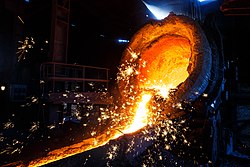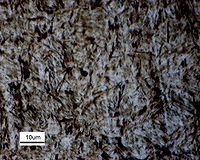Martensite: Difference between revisions
No edit summary |
No edit summary |
||
| Line 11: | Line 11: | ||
The martensite is formed by rapid cooling ([[quench]]ing) of [[austenite]] which traps carbon atoms that do not have time to diffuse out of the crystal structure. This martensitic reaction begins during cooling when the austenite reaches the martensite start temperature (M<sub>s</sub>) and the parent austenite becomes mechanically unstable. At a constant temperature below M<sub>s</sub>, a fraction of the parent austenite transforms rapidly, then no further transformation will occur. When the temperature is decreased, more of the austenite transforms to martensite. Finally, when the martensite finish temperature (M<sub>f</sub>) is reached, the transformation is complete. Martensite can also form by application of stress (this property is frequently used in toughened ceramics like yttria stabilised zirconia and in special steels like TRIP steels(i.e. transformation induced plasticity steels)). Thus Martensite can be thermally induced or stress induced. |
The martensite is formed by rapid cooling ([[quench]]ing) of [[austenite]] which traps carbon atoms that do not have time to diffuse out of the crystal structure. This martensitic reaction begins during cooling when the austenite reaches the martensite start temperature (M<sub>s</sub>) and the parent austenite becomes mechanically unstable. At a constant temperature below M<sub>s</sub>, a fraction of the parent austenite transforms rapidly, then no further transformation will occur. When the temperature is decreased, more of the austenite transforms to martensite. Finally, when the martensite finish temperature (M<sub>f</sub>) is reached, the transformation is complete. Martensite can also form by application of stress (this property is frequently used in toughened ceramics like yttria stabilised zirconia and in special steels like TRIP steels(i.e. transformation induced plasticity steels)). Thus Martensite can be thermally induced or stress induced. |
||
One of the differences between the two phases is that martensite has a body- |
One of the differences between the two phases is that martensite has a body-centred [[tetragonal]] (BCT) crystal structure, whereas austenite has a [[Cubic crystal system|face-centred cubic]] (FCC) structure. The transition between these two structures requires very little [[thermal activation]] energy because it is a [[martensitic transformation]], which results in the subtle but rapid rearrangement of atomic positions, and has been known to occur even at [[cryogenic]] temperatures. Martensite has a lower density than austenite, so that the martensitic transformation results in a relative change of volume.<ref name=EM2>{{cite book |last=Ashby |first=Michael F. |authorlink=M. F. Ashby|coauthors=& David R. H. Jones |title=Engineering Materials 2 |origyear=1986 |edition=with corrections |year=1992 |publisher=Pergamon Press |location=Oxford |isbn=0-08-032532-7}}</ref> Of considerably greater importance than the volume change is the shear strain which has a magnitude of about 0.26 and which determines the shape of the plates of martensite.<ref name=EM3>{{cite book |last=Bhadeshia |first=H. K. D. H.|authorlink=H. K. D. H. Bhadeshia |title=Geometry of Crystals |origyear=2001 |edition=with corrections |year=2001 |publisher=Institute of Materials |location=London |isbn=ISBN 0-904357-94-5}}</ref> |
||
Martensite is not shown in the equilibrium [[phase diagram]] of the iron-carbon system because it is not an equilibrium phase. Equilibrium phases form by slow cooling rates allowing sufficient time for diffusion, whereas martensite is usually formed by fast cooling rates. Since chemical processes (the attainment of equilibrium) [[activation energy|accelerate]] at higher temperature, martensite is easily destroyed by the application of heat. This process is called [[tempering]]. In some alloys, the effect is reduced by adding elements such as [[tungsten]] that interfere with [[cementite]] nucleation, but, more often than not, the phenomenon is exploited instead. Since quenching can be difficult to control, many steels are quenched to produce an overabundance of martensite, then tempered to gradually reduce its concentration until the right structure for the intended application is achieved. Too much martensite leaves steel [[brittleness|brittle]], too little leaves it [[Hardness|soft]]. |
Martensite is not shown in the equilibrium [[phase diagram]] of the iron-carbon system because it is not an equilibrium phase. Equilibrium phases form by slow cooling rates allowing sufficient time for diffusion, whereas martensite is usually formed by fast cooling rates. Since chemical processes (the attainment of equilibrium) [[activation energy|accelerate]] at higher temperature, martensite is easily destroyed by the application of heat. This process is called [[tempering]]. In some alloys, the effect is reduced by adding elements such as [[tungsten]] that interfere with [[cementite]] nucleation, but, more often than not, the phenomenon is exploited instead. Since quenching can be difficult to control, many steels are quenched to produce an overabundance of martensite, then tempered to gradually reduce its concentration until the right structure for the intended application is achieved. Too much martensite leaves steel [[brittleness|brittle]], too little leaves it [[Hardness|soft]]. |
||
Revision as of 22:53, 29 December 2010
| Steels |
|---|
 |
| Phases |
| Microstructures |
| Classes |
| Other iron-based materials |


This article needs additional citations for verification. (September 2009) |
Martensite, named after the German metallurgist Adolf Martens (1850–1914), most commonly refers to a very hard form of steel crystalline structure, but it can also refer to any crystal structure that is formed by displacive transformation. It includes a class of hard minerals occurring as lath- or plate-shaped crystal grains. When viewed in cross-section, the lenticular (lens-shaped) crystal grains appear acicular (needle-shaped), which is how they are sometimes incorrectly described.[vague]
In the 1890s, Martens studied samples of different steels under a microscope, and found that the hardest steels had a regular crystalline structure. He was the first to explain the cause of the widely differing mechanical properties of steels. Martensitic structures have since been found in many other practical materials, including shape memory alloys and transformation-toughened ceramics.
The martensite is formed by rapid cooling (quenching) of austenite which traps carbon atoms that do not have time to diffuse out of the crystal structure. This martensitic reaction begins during cooling when the austenite reaches the martensite start temperature (Ms) and the parent austenite becomes mechanically unstable. At a constant temperature below Ms, a fraction of the parent austenite transforms rapidly, then no further transformation will occur. When the temperature is decreased, more of the austenite transforms to martensite. Finally, when the martensite finish temperature (Mf) is reached, the transformation is complete. Martensite can also form by application of stress (this property is frequently used in toughened ceramics like yttria stabilised zirconia and in special steels like TRIP steels(i.e. transformation induced plasticity steels)). Thus Martensite can be thermally induced or stress induced.
One of the differences between the two phases is that martensite has a body-centred tetragonal (BCT) crystal structure, whereas austenite has a face-centred cubic (FCC) structure. The transition between these two structures requires very little thermal activation energy because it is a martensitic transformation, which results in the subtle but rapid rearrangement of atomic positions, and has been known to occur even at cryogenic temperatures. Martensite has a lower density than austenite, so that the martensitic transformation results in a relative change of volume.[1] Of considerably greater importance than the volume change is the shear strain which has a magnitude of about 0.26 and which determines the shape of the plates of martensite.[2]
Martensite is not shown in the equilibrium phase diagram of the iron-carbon system because it is not an equilibrium phase. Equilibrium phases form by slow cooling rates allowing sufficient time for diffusion, whereas martensite is usually formed by fast cooling rates. Since chemical processes (the attainment of equilibrium) accelerate at higher temperature, martensite is easily destroyed by the application of heat. This process is called tempering. In some alloys, the effect is reduced by adding elements such as tungsten that interfere with cementite nucleation, but, more often than not, the phenomenon is exploited instead. Since quenching can be difficult to control, many steels are quenched to produce an overabundance of martensite, then tempered to gradually reduce its concentration until the right structure for the intended application is achieved. Too much martensite leaves steel brittle, too little leaves it soft.
See also
References
- ^ Ashby, Michael F. (1992) [1986]. Engineering Materials 2 (with corrections ed.). Oxford: Pergamon Press. ISBN 0-08-032532-7.
{{cite book}}: Unknown parameter|coauthors=ignored (|author=suggested) (help) - ^ Bhadeshia, H. K. D. H. (2001) [2001]. Geometry of Crystals (with corrections ed.). London: Institute of Materials. ISBN ISBN 0-904357-94-5.
{{cite book}}: Check|isbn=value: invalid character (help)
